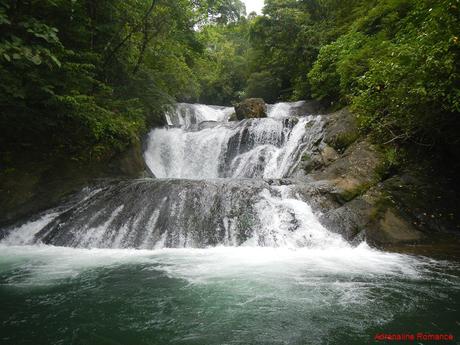
We are inexorably fascinated with our country’s waterfalls. These stunning works of Mother Nature speak volumes of beauty, allure, and power. They are venues for heart-stopping adventures, sanctuaries for serenity, and sources for a land’s commerce and survival. Thus, when we knew that one of our destinations during our Experience Antique familizarization tour is the magnificent Igpasungaw Falls in the municipality of Sebaste, our hearts beat with excitement and delight.
After our thrilling river tubing adventure at Bugang River and a nice visit at the LA Dioso Memorial Public library, it was time for a nearly one-hour ride to the municipality of Sebaste. After picking up our guide, we headed to the inland sitio of Igpatuyaw where our destination lies.
When we arrived at Igpatuyaw, the entire sitio was quiet as people went inside their homes to watch noontime shows and take refuge from the noon sun’s heat. This old woman however snubbed the onslaught of the fiery ball in the sky while tending to rice grains being dried under the sun. Once completely dried, the grains are then taken to the mill.

Sebaste, like the rest of Antique, is incredibly green and unspoiled. Check out those lovely mountains, expansive rice fields, and thick woods. No wonder the air here is cool and refreshing.

After a short briefing, we started a 45-minute hike to Igpasungaw Falls. The trail started with an exposed farm trail, which meant that the noontime sun bombarded us with its full power. Thankfully though, large trees and thick plants rose on either side of the trail and provided us a good degree of shade.
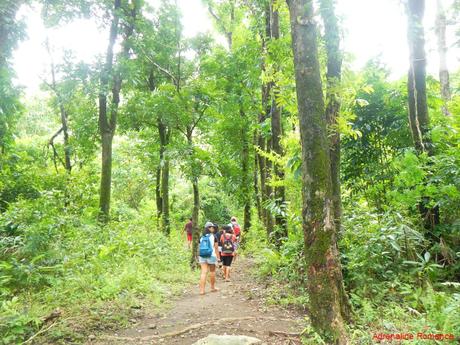
Along the way, we found cool blossoms which we haven’t encountered in the city. This one has an identity crisis. Is it a flower or a fruit?
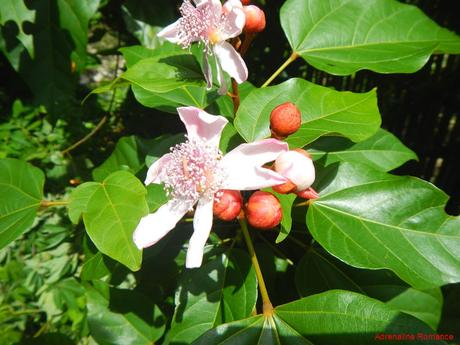
The sound of a powerful river serenaded us as we continued hiking the easy trail. Isn’t that gorgeous? With the heat becoming more intense by the minute, we found it very hard to resist the temptation to simply jump into the clean water.
This river—we failed to ask the guides what is its name—seems to be the source of potable water in Sebaste due to the presence of large pipes and humming pumps.
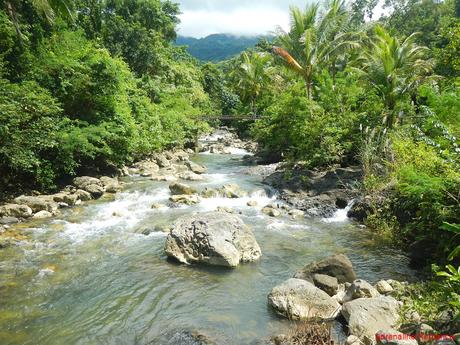
Halfway through the hike, we chanced upon a small waterfall that crossed our trail. Be careful, the rocks at the bottom of the falls are quite slippery.
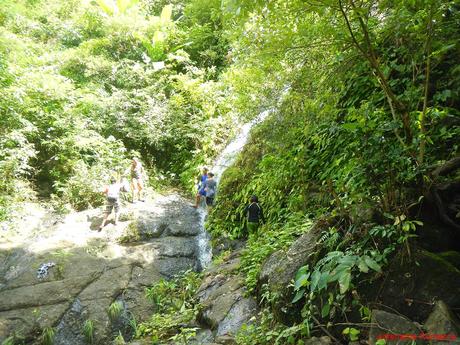
Sweetie didn’t hesitate to take a refreshing shower. The fresh water washed away the sweat and cooled off our overheated bodies.

Well, we stand corrected when we said “small” waterfall. It turned out that the place where we took a quick shower before resuming the hike was just the bottom part of a large, tall waterfall that hugs a cliff! It looks like a big sister of the 5th level of Aguinid Falls in Samboan, Cebu.
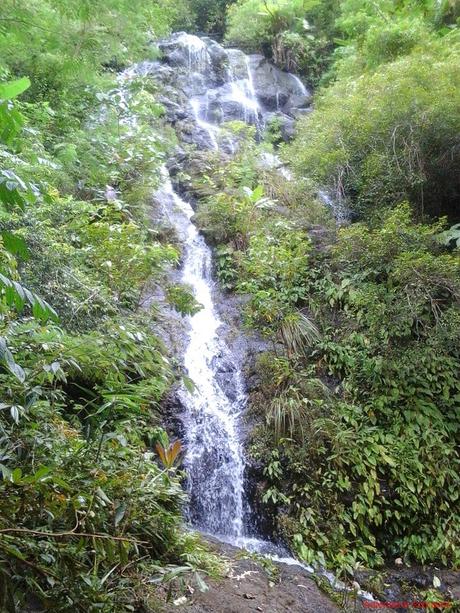
At times we had to cross rickety bamboo bridges to get across gaps and ravines. Although they’re tough, our hearts skipped at times when we step on soft, rotten bamboo or when bridges creaked.
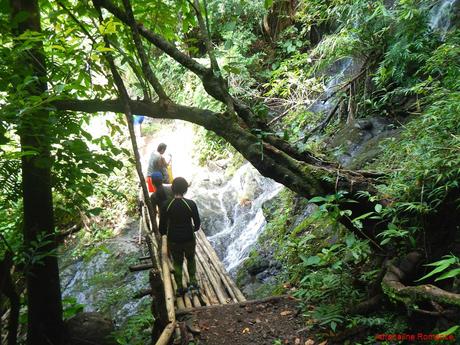
After 45 minutes of trekking, we reached a wild, roaring part of the river where the current was considerably strong. In these noisy canyons, our real adventure began.
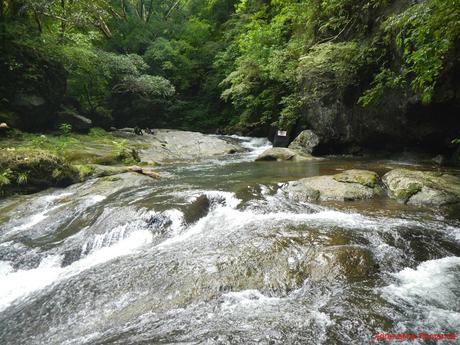
To get to our first destination, we had to cross the river, and that involves fighting against the strong current. This is difficult because the riverbed is very slippery, and many of the rocks underneath the surface are loose. The undercurrent can quickly knock down even the strongest person.
Crossing the river therefore required a long root to be used as a sturdy line, sure footing, and a lot of teamwork.
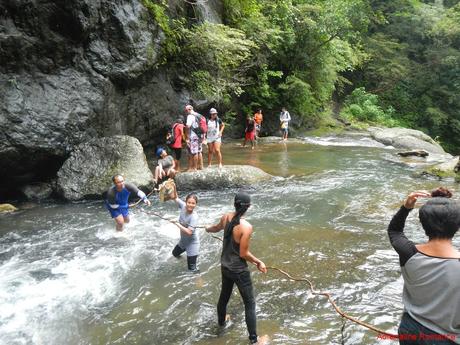
If you trip and the current sweeps you off (knocks on wood), you will be swept away through these series of waterfalls. As you can probably see in the photo below, the river’s flow is powerful!
Igpasungaw Falls is not a single waterfall. Rather, it is a series of nine cascading waterfalls, some of which are yet to be explored. The waterfalls and the river itself are fueled by rainwater and hidden springs far beyond the mountains.

After crossing the river and enduring an easy 10-minute hike, we arrived at the known second main waterfall. This is a popular spot for locals since the pool beneath the waterfall has just the right level of depth for swimmers and non-swimmers alike.
By carefully inching towards the mossy natural spillway and anchoring to a solid crevice, one can let the strong current massage his or her back. Talk about nature’s spa!
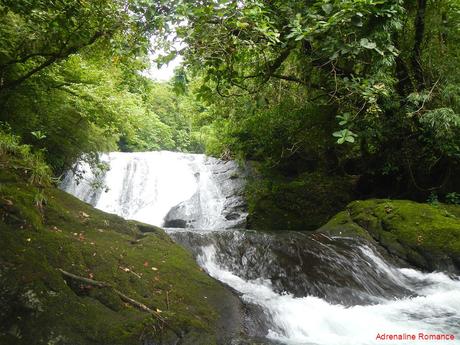
Let’s take a closer look, shall we? This is a classic example of a slide waterfall, a type of horsetail waterfall in which the water is in continuous contact with the bedrock all the time. We estimate the height of this monster to be around 30 to 40 feet.
If the bedrock doesn’t have sharp edges or crevices, this would be a fun long natural water slide.
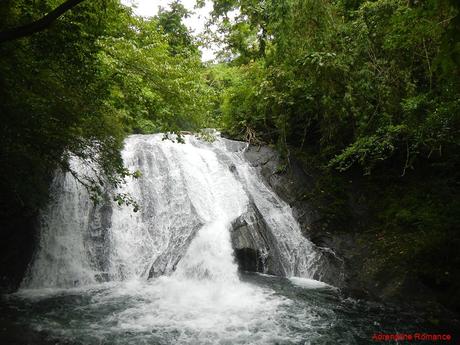
After munching on some sweet local suman and bibingka (rice cake), we decided to visit the known top level of Igpasungaw Falls. Since the trail lies on the other side, we need to do another river crossing.
Teamwork is again needed to safely get across the fast-moving river.
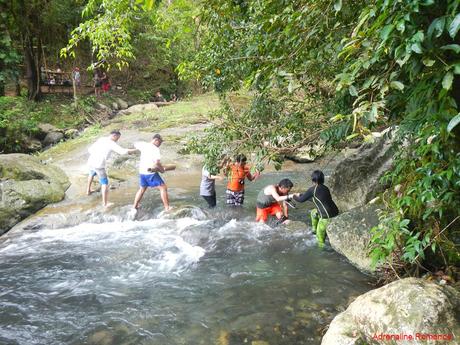
The current is much stronger here than our first river crossing because the water coming from the second fall is forced through this narrow, slippery channel. The channel empties into another tall waterfall below us. Thus, extra care is required.
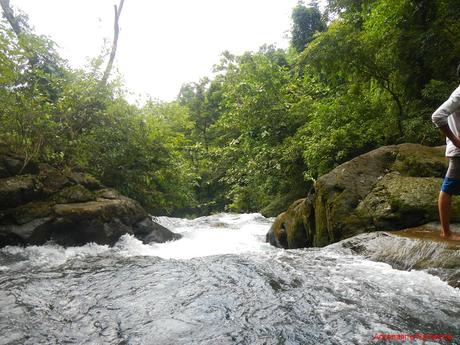
The challenge and danger wasn’t over yet! While ascending to the top level, a mossy outcropping blocked the trail. We need to exercise extreme caution as there is only one tiny crack (just deep enough for our toes to step on) on the slippery surface to act as a foothold. For a handhold, we were left with a wet, awkwardly shaped sloper.
Later, when we met with Sebaste Mayor Gaseva Recopuerto, we recommended attaching a fixed line in this section for safety. The line will act as a handrail to aid visitors during the traverse.
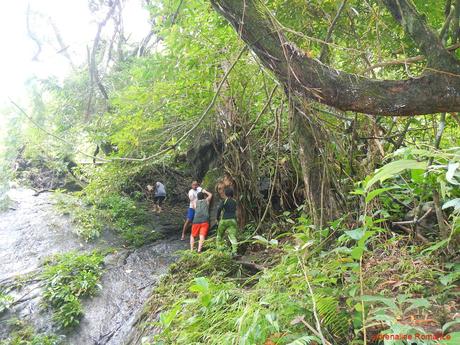
That’s the top of the second waterfall. An unlucky fall from the cliff here is rarely fatal as the slippery bedrock leads back to the pool of the second waterfall. Still, such a fall can cause a few cuts or minor to moderate injuries.
Seeing the water from here makes the daredevils in us want to jump. Hehehe!
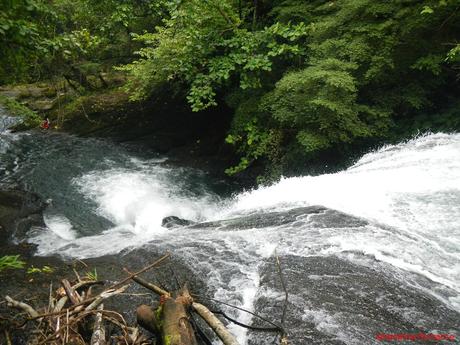
The known top level of Igpasungaw Falls greeted us with all its proud splendor. The sound of gushing water was Mozart to our ears, a far cry from the unnatural cacophony in the busy city. Nature’s music and scenery was so soothing that Sir Flord simply rolled out his Ati banig and lay on it, oblivious to the happy people who swam in the waterfall’s pool.
To give you an idea of the size of the waterfall, check out the photo below. That’s Maam Detchie, Sir Flord’s wife, slowly inching towards a fun part of the cascade.
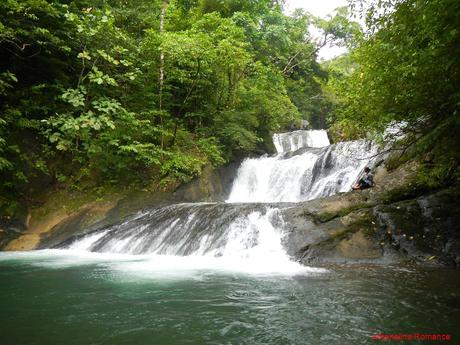
This level is an example of a classic tiered or multi-step waterfall. Each drop is similar to each other and has its own sunken plunge pool. We tried to get to the top of the highest tier, but we couldn’t find a trail.
For more than an hour, we had so much fun sliding down the waterfall that forms the first tier.

Ominous dark clouds gathered in the sky, and we know what that means; the river could turn into a raging monster. Thus, we grudgingly left our three-tiered playground and backtracked towards the second waterfall.
From there, we took a different rocky and mossy trail to get further down. Along the way, we
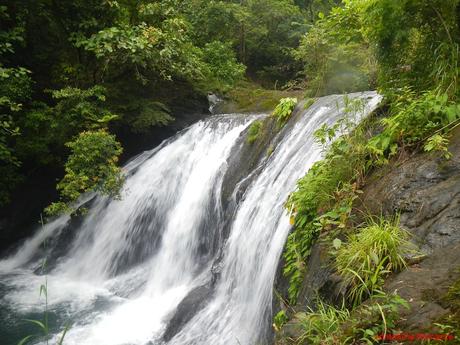
The first level of Igpasungaw Falls is definitely massive and overflowing with strength! In fact, looking at it reminded us of the gigantic Tinuy-an Falls in Bislig. Rappeling here would be totally fun.
With all these rapids and tiers, Igpasungaw Falls is a perfect venue for the first canyoning adventure in Antique.
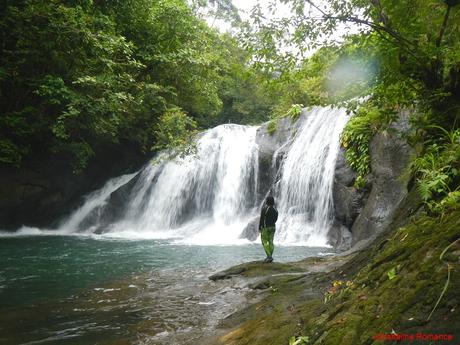
Roiling rapids noisily joined the calls of birds and rustling leaves. Good thing it didn’t rain because if it did, these rapids, which are enclosed in a rocky canyon, may become truly dangerous.
We were intrigued and concerned when we saw a that said “Washing Area.” We truly hope that no one actually washes clothes here. Not only is the area dangerous for washing, but laundering clothes here can also severely damage the river. Detergents are pollutants that can produce an overabundance of algae, which suffocates the river.
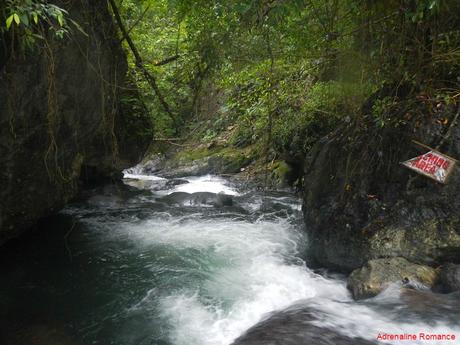
After taking photos, it was time to go back to the jump-off. One of the highlights was traversing this old and slippery log bridge while holding on to bamboo rails.
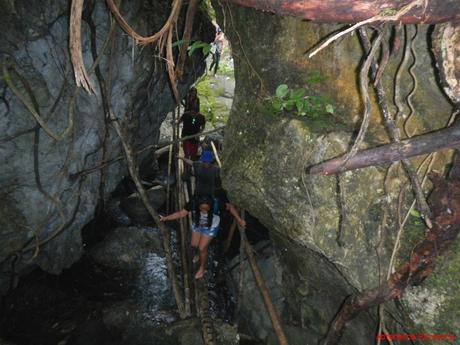
Even the strongest person and the most coordinated teamwork can sometimes fail. Several of us slipped while crossing this section due to the combined assault of a powerful undercurrent and uncharted riverbed.
It was a good thing that the pool below the small waterfall was shallow and surprisingly calm. Otherwise, we would have been swept away downstream.

The firebrand river probably thought, Let’s see what these guys are really made of. Bwahahaha!
That’s because when we arrived at the first river crossing, the flow of the water was noticeably stronger. Remember that we already had difficulty crossing the span a few hours earlier.
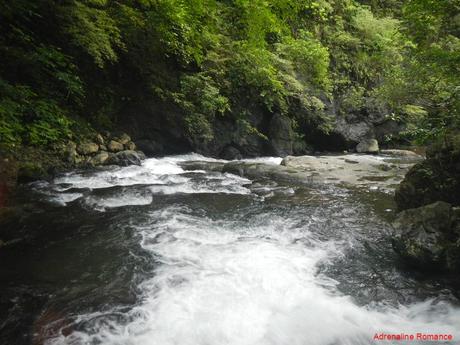
Reconnecting with the trail, we arrived at our jump-off point after almost an hour’s hike. That was pretty good timing because once our van rolled down the road, the sky opened its dams. If we were still in the river when the rain caught up with us, we would be in serious trouble!
The downpour became increasingly heavy; and by the time we reached Annie Sophie Hotel where we were going to spend the night, the rain has turned into a full cloudburst.
We were cold and drenched to the bone. But that was quickly remedied when Maam Thelma Palacios, the owner of Anna Sophie Hostel treated us with a warm dinner of hot chicken tinola, fresh boiled tahong (clams), and an assortment of vegetables.

However, the stars of our dinner were these delicious, perfectly fried freshwater crayfish. We bought them from a young local gatherer whom we have met during our descent from Igpasungaw Falls. We finished two bowls of the stuff!
The meat inside was firm, sweet, and luscious. The taste borders between that of crab and shrimp.
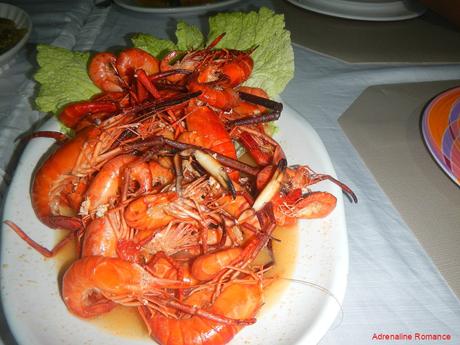
Heavy rains prevented us from going outside the hostel; so we simply stayed there to relax, work on some online projects, or watch some movies.
The morning after shone bright and sunny. Anna Sophie Hostel has a beautiful garden courtyard with rare orchids hanging over the place. It’s a great place to enjoy a hot breakfast, which we did.
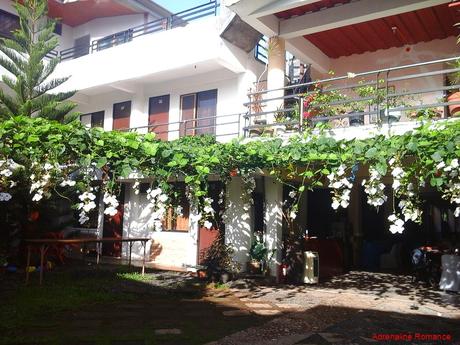
The wild and dazzling Igpasungaw Falls is undoubtedly Sebaste’s crown jewel. It is a promising eco-tourism paradise for thrill-seekers and a potential venue for canyoning, rafting, river trekking, and other water sports. Who knows what other wonders and adventures lie beyond this magnificent, natural staircase? Visit Igpasungaw Falls now!
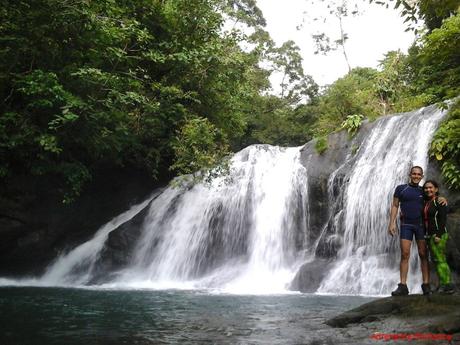
Contact Details
To facilitate your tour around Sebaste, Antique, get in touch with the following:
- Mr. Nilo Paulino (Sebaste Tourism Officer) – 0912-660-0067
- Mr. Flord Calawag (OIC Antique Provincial Tourism Office) – 0927-699-5727 / 0919-813-9893
- Ms. Jola Lyn Tingson (Antique Natural Tourism Program Head) – 0977-811-0017
We strongly recommend contacting any of these officers before your trip so they can coordinate with the accommodation providers and the necessary people to help you in your adventures. They are the best people to go to if you want your adventure to be smooth-sailing.
Once you arrive in Sebaste, head first to the municipal hall to register. Then see the tourism officer/staff for assistance.
Rates*
Transportation (same rates apply on the return trip)
- P 90 per person – bus fare from Kalibo to Sebaste Town Proper
- P 120 per person – bus fare from Iloilo City to Sebaste Town Proper
- P 100 per person – van fare from Kalibo to Sebaste Town Proper
- P 250 per person – van fare from Iloilo City to Sebaste Town Proper
- P 20 per person – habal-habal fare from Sebate Town Proper to Igpasungaw Falls**
** We strongly recommend you negotiate with the driver to wait for you or to fetch you at a scheduled time. Returning to Sebaste from Igpasungaw Falls is quite difficult because only a few public vehicles actually go there. Most guests ride private or hired vehicles.
Igpasungaw Falls Related Fees
- P 50 per person – environmental/entrance fee
- P 250 per 5 guests – guide fee (1 guide for 5 people)
* Rates are subject to change without prior notice. We did not include our expenses for meals, snacks, souvenirs, accommodations, tips, and other fees in this rate sheet as you may have different needs, preferences, itineraries, and sharing scheme from us.
Tips
1. For large groups or for a more private tour, you can hire an air-conditioned van from Southwest Tours. Use the following contact details:
- Cellphone Numbers: 0917-568-2441 or 0947-891-1658
- Email: [email protected]
2. For accommodations in Sebaste and Culasi, stay at the Anna Sophie Hostel. Get in touch with Ms. Thelma Palacios, Hostel Owner. Use the following contact details for bookings, reservations, and information.
- Mailing Address: Felipe S. Alpas St. Centro Sur, Culasi, Antique 5708
- Mobile Numbers: 0920-4762508
- Email: [email protected]
- Facebook Page: Anna Sophie Hostel
3. Take extra care when crossing the river because the undercurrent is quite strong. Hold on to rocks, crevices, safety lines, and each other’s hand. The riverbed may be mossy or made up of loose rocks; so take time to probe the riverbed with a trekking pole, stick, or your own foot before crossing.
If you are carrying a backpack, unclip the waist belt and the chest strap before crossing the river. In that way, in case you trip and get swept away, you can easily and quickly get rid of your backpack, which could drag you underwater.
4. In the absence of more sturdy bridges or safety lines, at the first sign of rain, stop what you are doing and return immediately to the trail. You don’t want to be stranded in the river. Do not attempt to cross the river in case you get caught in a flashflood!
5. In the same manner, be careful when climbing up or down the waterfalls. The rocks are mossy and are quite slippery.
6. Don’t make high dives no matter how tempting the water is without asking your guide’s permission.
7. Even if you are a strong swimmer, stay well away from the spot where the flow of water falls directly. Igpasungaw Falls is quite powerful, and the falling water and undercurrent can push you down the surface.
If you wish to go to the roiling froth, use caution in swimming towards the waterfall. Identify shallow places and anchors where you can immediately head to in case the force of the water overcomes your strength.
8. Pack light but do bring the following:
- water (at least 1 liter)
- umbrella, hat, or malong (sun protection)
- swimwear, rash guard, cycling shorts
- trekking sandals or shoes
- extra dry clothes
- snacks
- extra money for emergencies
9. Waterproof your stuff by wrapping them in plastic bags before putting them in your backpack.
10. Do not litter, and bring all your garbage with you.

